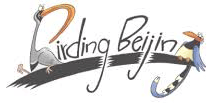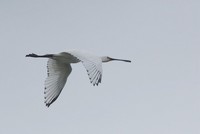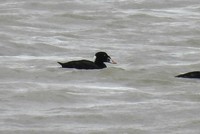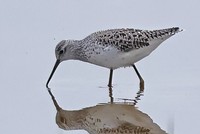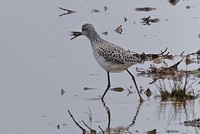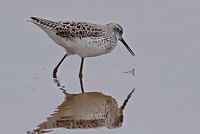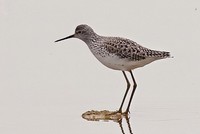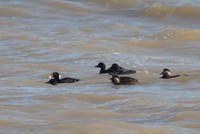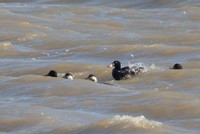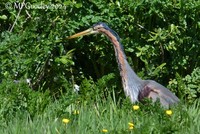The following article was originally published on birdingbeijing.com on 02 March and is reproduced with permission here.
The Invisible Killer: Mist Nets At Chinese Airports
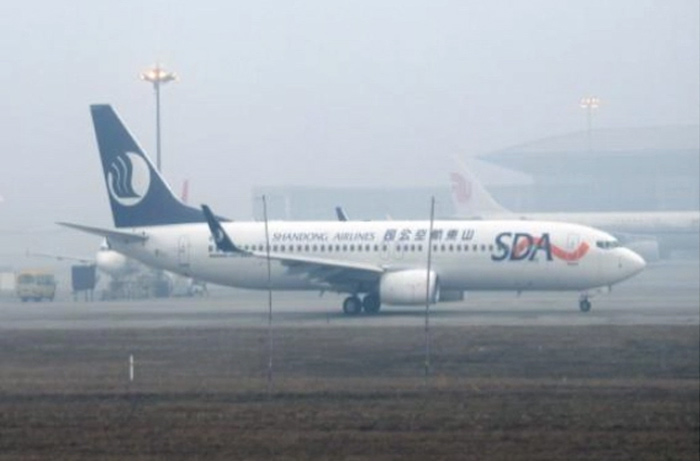
Any eagle-eyed birder or nature-lover arriving in Beijing by air during daylight hours will be shocked to see lines of mist nets alongside the runway. Entangled bodies of birds, bats and flying insects dangle pathetically in the breeze, lifeless after having suffered a horrible, prolonged death. I remember the first time I visited China and, as my plane turned onto the runway and accelerated for take off for the return flight to London, I couldn’t help feeling sad that so many birds would die to allow me to travel in a machine that is essentially a poor imitation of nature’s perfect design.
What puzzled me was that I hadn’t seen anything like this at airports in other countries.. There were questions in my head. First, what was the risk of bird-strikes in Beijing? As I could see, there were very few gulls, geese or other large birds close to the airport.. Second, even if the risk was high, was it really necessary to use mist-nets – an indiscriminate killer of mostly small birds – to mitigate that risk? And finally, how did other countries tackle the risk of bird strikes?
After living in China for 5 years, I now realise that it is not only in Beijing where these nets are deployed but at almost every airport I have visited in mainland China (there are now more than 300 of them!). A rough calculation of just how damaging these nets are to wild birds provides some alarming results. Nets are typically 20m long and set about 5m apart. If we consider 300+ airports with an average 3km of runway each, protected by strings of nets down one or both sides, we can estimate there are at least 900 x 40 = 36,000 mist nets operating 365 days a year. This computes to more than 13 million net days. If each net catches only one bird per day (a rather conservative estimate – some will catch many more, especially during the spring and autumn migration seasons) this would mean a minimum of 13 million birds killed each year!
It’s an issue I have been meaning to look into for some time and, prompted by the discussion in a recent Sinica podcast and conversations with John Mackinnon and Patrick Haverman at UNDP in the last few weeks, I have taken some time to research the issue.
The Risks
It is clear that bird-strikes are a serious risk to aircraft and passenger safety. According to the Airports Council International, in the USA alone, there have been 119,917 strikes involving wildlife reported between 1990 and 2011, with damage costing approximately USD 480 million (Federal Aviation Administration 2012). And since 1988, 231 people have been killed as a result of bird strikes and over 220 aircraft have been destroyed. It is no surprise, therefore, that airport authorities take very seriously the risk to aircraft from bird-strikes.
The danger of small birds causing serious damage to aircraft is very low. Single small birds weighing less than 50 g (e.g. a skylark or pipit) – species most likely to be caught in mist nets – pass right through jet turbines with usually no damage to the aircraft or passengers. The risk is with heavier birds. As a guide, birds that tend to flock and weigh more than 1.8 kg can cause the most severe damage to aircraft. Hitting unusually large flocks of migrating birds, especially large geese, swans, ducks, gulls, eagles and vultures can cause serious damage. Lines of mist nets at ground level will be ineffective at mitigating this risk.
The precise nature of the risk will be different for each individual airport according to the species recorded in and around the airport. This, in turn, will depend on the location of the airfield, the proximity of habitat attracting large birds and how the habitat within the airport perimeter is managed.
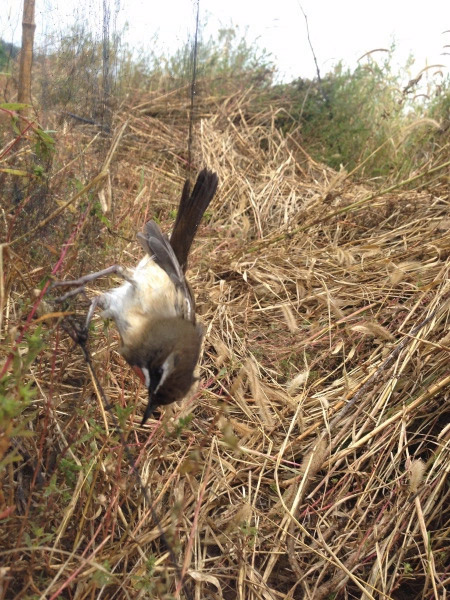
nets at China’s airports. This photo of a Siberian Rubythroat caught in
a typical mist net in China. (© Terry Townshend)
Assessing the risk
Fortunately, after some basic research, I found out that there is help out there for airport authorities. The Airports Council International has published a Wildlife Hazard Management Handbook that outlines the recommended approach to assessing and managing the risk of wildlife strikes at airports. Interestingly, the handbook DOES NOT mention mist nets as a recommended form of bird control.
The Handbook recommends that every airport produces a risk assessment. This involves identifying the species present and their potential damage should they be struck by an aeroplane. Once this list is compiled, there should be a review of past wildlife strikes to assess the likelihood of each species being involved in a collision. The product of these two steps gives the risk for each species. The Risk Assessment ranks the risk of each species and highlights those that should be prioritized for risk mitigation.
Next comes a habitat management plan to reduce the attractiveness of the airport and the surrounding area to the species identified as the greatest risk.
Finally, the airport authorities should develop a Wildlife Hazard Management Plan (WHMP). The WHMP sets out the actions required to reduce wildlife hazards in and around critical aircraft operating areas, and therefore decrease the risk of a strike, based on the risk assessment.
The Wildlife Hazard Management Handbook recommends the following (in priority order):
Location: Position airports and align runways away from known bird concentrations, nature reserves and known migration pathways.
On-site habitat management: For example, keep grass short so as to provide little cover or food for birds and cover any water collection/run-off to avoid attracting large water birds.
Off-site habitat: As far as possible, ensure land-uses around airports are not major attractions for birds such as attractive wetlands, fruit orchards, bird attractive agricultural crops or bird roosts, rubbish tips and nesting trees or beaches.
Patrols: Regular surveillance of the airfield is necessary to spot hazardous wildlife. The use of binoculars, spotting scopes and possibly night vision equipment by trained staff allows for optimum observation.
Intervention techniques: Most intervention techniques rely on scaring wildlife with an audible or visual threat. According to the Handbook, these can include the following:
- Movement of the patrol vehicle to the vicinity of the target species
- Noise to scare wildlife such as sound generators, pistol or gun shots, and pyrotechnics or firecrackers.
- Noise to deter wildlife such as recorded distress or alarm calls.
- Visual repellents including lasers, kites, balloons, scarecrows and small models.
- Trained predators such as falcons and dogs used to chase wildlife.
- Trapping, tagging and relocation, especially for larger animals and protected species.
- Culling or killing (this is a last resort, as a dead animal is not a trained animal.)
- In some situations chemical repellents and pesticides might have a role to play, although the use of poisons and environmental pollutants should be discouraged. The Wildlife Hazard Managament Handbook clearly states that “It is the responsibility of the aerodrome operator to deliver solutions that maintain aviation safety whilst conserving the species in question”
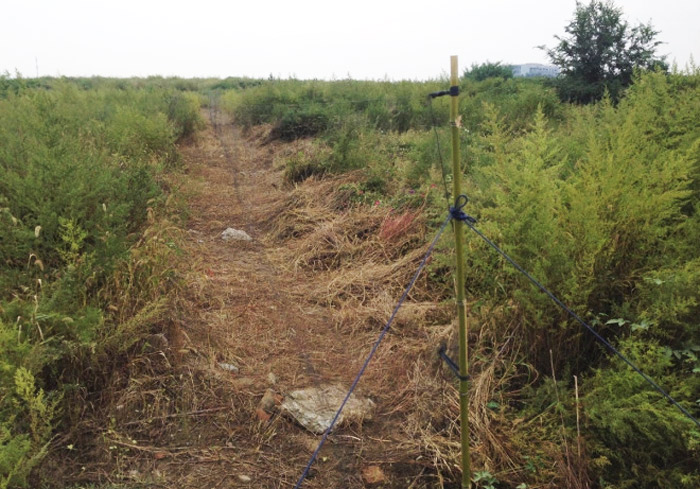
The Situation In Beijing
Unfortunately, at present, the Chinese authorities use a rather blunt (and likely ineffective) technique to reduce the risk of bird-strikes – lines and lines of mist nets. These nets may reduce numbers of certain smaller species such as pipits, larks and wagtails – all representing a very low risk to aircraft safety – but they do very little to impact the species that provide the highest risk, for example swans, geese, gulls etc. In fact, in the case of Beijing, large birds are very scarce near to the airport.. there are no flocks of feral geese, large gulls, ducks or any other large bird in the vicinity. It seems so unnecessary to erect kilometres of mist nets.
Perhaps appearances can be deceptive and a robust risk assessment has been made and the nets are a product of the specific risks that Beijing, and other Chinese airports, face. If so, the airport authorities should publish that information and explain why this cruel practice is necessary. It is, perhaps, significant that the airport in Hong Kong, a part of China that enjoys greater transparency, does not employ mist nets but instead uses non-lethal intervention measures such as flares and sound-based techniques.
I’ll be discussing this issue with the China Birdwatching Society to explore whether they would be willing to approach the airport authorities. As well as setting a terrible example which surely makes it more difficult to tackle illegal poaching, the practice of using mist nets at airports appears inconsistent with President Xi Jinping’s more environmentally-friendly rhetoric and a stronger focus on environmental issues expected in the next Five Year Plan. Using mist nets seems to be a risk mitigation method that is unnecessary, out of touch and inconsistent with the new, modern China.
Terry Townshend
birdingbeijing.com
05 March 2016
Birding Beijing
Birding Beijing was launched in August 2010 by Terry Townshend, a British birder living and working in Beijing. Through this blog he celebrates the birds that can be found in and around China’s vibrant capital city. He is indebted to the growing number of birders in Beijing, both Chinese and expat, who contribute a huge amount to the content found on this site.
A passionate conservationist, Terry has spearheaded efforts to save some of China’s most endangered birds, in particular the Jankowski’s Bunting, a poorly known bird living in remote northeast China with a known population of under 100 pairs. In 2012 he became a Species Champion with BirdLife International.
Terry is dedicated to encouraging young people to learn, and care, about the environment and loves nothing more than showing students, children and visitors to Beijing the wonders of the birds that can be found here. He has a prominent media profile, often being asked to comment on environmental issues and featuring on mainstream TV, lifestyle magazines and in national and international newspapers.
Terry has found several new birds for Beijing, including the capital’s first Tree Pipit in the UK Ambassador’s garden (!). He is a regular contributor to the Beijing Birdwatching Society’s lecture series and, earlier this year, was honoured to deliver the keynote lecture at the National Zoological Museum to celebrate China’s National Bird Day.
He is a co-author on Europe’s leading birding blog, Birding Frontiers and, since 2014, he has been a Brand Ambassador for Swarovski Optik.



